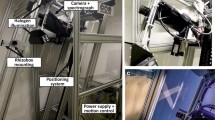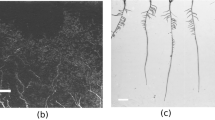Abstract
Aims
Roots are vital organs for plants, but the assessment of root traits is difficult, particularly in deep soil layers under natural field conditions. A popular technique to investigate root growth under field or semi-field conditions is the use of minirhizotrons. However, the subsequent manual quantification process is time-consuming and prone to error.
Methods
We developed a multispectral minirhizotron imaging system and a subsequent image analysis strategy for automated root detection. Five wavelengths in the visible (VIS) and near-infrared (NIR) spectrum are used to enhance living roots by a multivariate grou** of pixels based on differences in reflectance; background noise is suppressed by a vesselness enhancement filter. The system was tested against manual analysis of grid intersections for both spring barley (Hordeum vulgare L.) and perennial ryegrass (Lolium perenne L.) cultivars at two time-points. The images of living roots were captured in wet subsoil conditions with dead roots present from a previous crop.
Results
Under the soil conditions used in the study, NIR reflectance (940 nm), provided limited ability to separate between rhizosphere components, compared to reflectance in the violet and blue light spectrum (405 nm and 450 nm). Multivariate image analysis of the spectral data, combined with vesselness enhancement and thresholding allowed for automated detection of living roots. Automated image analysis largely replicated the root intensity found during manual grid intersect analysis of the same images. Although some misclassification occurred, caused by elongated structures of dew and chalkstone with similar reflectance pattern as living root, the system provided similar or in some cases improved detection of genotypic differences in the total root length within each tube.
Conclusion
The multispectral imaging system allows for automated detection of living roots in minirhizotron studies. The system requires considerably less time than traditional manual recording using grid intersections. The flexible training strategy used for root segmentation offers hope for the transfer to other rhizosphere components and other soil types of interest.







Similar content being viewed by others
Abbreviations
- ANCOVA:
-
Analysis of covariance
- ANOVA:
-
Analysis of variance
- AI:
-
Automated image analysis
- M:
-
Manual grid intersections
- MR:
-
Minirhizotron
- NIR:
-
Near-infrared
- nCDA:
-
normalized Canonical Discriminant Analysis
- BBCH:
-
Scale to identify the phonological development stages of plants
- VIS:
-
Visible
References
Arsenault JL, Pouleur S, Messier C, Guay R (1995) WinRhizo, a root measuring system with a unique overlap correction method. HortScience 30:906
Atkinson JA, Pound MP, Bennett MJ, Wells DM (2019) Uncovering the hidden half of plants using new advances in root phenoty**. Curr Opin Biotechnol 55:1–8. https://doi.org/10.1016/j.copbio.2018.06.002
Baumgardner MF, Silva LRF, Biehl LL, Stoner ER (1986) Reflectance properties of soils. Adv Agron 38:1–44. https://doi.org/10.1016/S0065-2113(08)60672-0
Bennie ATP, Taylor HM, Georgen PG (1987) An assessment of the core-break method for estimating rooting density of different crops in the field. Soil Tillage Res 9:347–353. https://doi.org/10.1016/0167-1987(87)90059-6
Bock CH, Poole GH, Parker PE, Gottwald TR (2010) Plant disease severity estimated visually, by digital photography and image analysis, and by hyperspectral imaging. CRC Crit Rev Plant Sci 29:59–107. https://doi.org/10.1080/07352681003617285
Böhm W (1978) Untersuchungen zur Wurzelentwicklung bei Winterweizen. Z Acker Pflanzenbau 147:264–269
Borg H, Grimes DW (1986) Depth development of roots with time : an empirical description. Trans ASAE 29:194–197. https://doi.org/10.13031/2013.30125
Chevallier S, Bertrand D, Kohler A, Courcoux P (2006) Application of PLS-DA in multivariate image analysis. In: Journal of Chemometrics. Wiley-Blackwell, pp 221–229
Daughtry CS, McMurtrey JE, Chappelle EW et al (1995) Potential for discriminating crop residues from soil by reflectance and fluorescence. Agron J 87:165–171. https://doi.org/10.2134/agronj1995.00021962008700020005x
Delannay X, Palmer R (1982) Four genes controlling root fluorescence in soybean. Crop Sci 22:2–5. https://doi.org/10.2135/cropsci1982.0011183X002200020019x
Dissing BS, Papadopoulou OS, Tassou C et al (2013) Using multispectral imaging for spoilage detection of pork meat. Food Bioprocess Technol 6:2268–2279. https://doi.org/10.1007/s11947-012-0886-6
do Rosário G, Oliveira M, van Noordwijk M, Gaze SR et al (2000) Auger sampling, ingrowth cores and pinboard methods. In: Root methods. Springer Berlin Heidelberg, Berlin, pp 175–210
Dörge T, Carstensen JM, Frisvad JC (2000) Direct identification of pure Penicillium species using image analysis. J Microbiol Methods 41:121–133. https://doi.org/10.1016/S0167-7012(00)00142-1
Efroymson MA (1960) Multiple regression analysis. In: Ralston A, Wilif HS (eds) Mathematical methods for digital computers. Ralston A. Wiley, New York
Eshel A, Beeckman T (2013) Plant roots : the hidden half. CRC Press
Floyd DJ, Barker RE (2002) Change of ryegrass seedling root fluorescence expression during three generations of seed increase. Crop Sci 42:905–911. https://doi.org/10.2135/CROPSCI2002.9050
Frangi AF, Niessen WJ, Vincken KL, Viergever MA (1998) Multiscale vessel enhancement filtering. Springer, Berlin, pp 130–137
Fu W, Breininger K, Schaffert R et al (2018) Frangi-Net. In: Bildverarbeitung für die Medizin 2018. Springer Vieweg, Berlin, pp 341–346
Gamalero E, Trotta A, Massa N et al (2004) Impact of two fluorescent pseudomonads and an arbuscular mycorrhizal fungus on tomato plant growth, root architecture and P acquisition. Mycorrhiza 14:185–192. https://doi.org/10.1007/s00572-003-0256-3
Kimura K, Kikuchi S, Yamasaki S (1999) Accurate root length measurement by image analysis. Plant Soil 216:117–127. https://doi.org/10.1016/j.agwat.2007.03.002
Kirkegaard JA, Lilley JM, Howe GN, Graham JM (2007) Impact of subsoil water use on wheat yield. Aust J Agric Res 58:303–315. https://doi.org/10.1071/AR06285
Kroon D-J (2018) Hessian based Frangi Vesselness filter. In: MATLAB Cent. https://uk.mathworks.com/matlabcentral/fileexchange/24409-hessian-based-frangi-vesselness-filter. Accessed 1 Feb 2018
Le Bot J, Serra V, Fabre J et al (2009) DART: a software to analyse root system architecture and development from captured images. Plant Soil 326:261–273. https://doi.org/10.1007/s11104-009-0005-2
Lenth RV (2016) Least-squares means: the {R} package {lsmeans}. J Stat Softw 69:1–33. https://doi.org/10.18637/jss.v069.i01
Lobell DB, Asner GP (2002) Moisture effects on soil reflectance. Soil Sci Soc Am J 66:722. https://doi.org/10.2136/sssaj2002.7220
Lynch JP (2013) Steep, cheap and deep: an ideotype to optimize water and N acquisition by maize root systems. Ann Bot 112:347–357. https://doi.org/10.1093/aob/mcs293
Maeght J-L, Rewald B, Pierret A (2013) How to study deep roots-and why it matters. Front Plant Sci 4:299. https://doi.org/10.3389/fpls.2013.00299
Manschadi AM, Christopher J, deVoil P, Hammer GL (2006) The role of root architectural traits in adaptation of wheat to water-limited environments. Funct Plant Biol 33:823. https://doi.org/10.1071/FP06055
Menze BH, Jakab A, Bauer S et al (2015) The multimodal brain tumor image segmentation benchmark (BRATS). IEEE Trans Med Imaging 34:1993–2024. https://doi.org/10.1109/TMI.2014.2377694
Nakaji T, Noguchi K, Oguma H (2007) Classification of rhizosphere components using visible–near infrared spectral images. Plant Soil 310:245–261. https://doi.org/10.1007/s11104-007-9478-z
Nater EA, Nater KD, Baker JM (1992) Application of artificial neural system algorithms to image analysis of roots in soil, I. initial results. Geoderma 53:237–253. https://doi.org/10.1016/0016-7061(92)90057-E
Olesen MH, Carstensen JM, Boelt B (2011) Multispectral imaging as a potential tool for seed health testing of spinach (Spinacia oleracea L.). Seed Sci Technol 39:140–150. https://doi.org/10.15258/sst.2011.39.1.12
Pierret A (2008) Multi-spectral imaging of rhizobox systems: new perspectives for the observation and discrimination of rhizosphere components. Plant Soil 310:263–268
Pierret A, Gonkhamdee S, Jourdan C, Maeght JL (2013) IJ_Rhizo: an open-source software to measure scanned images of root samples. Plant Soil 373:531–539. https://doi.org/10.1007/s11104-013-1795-9
Pinheiro J, Bates D, DebRoy S, et al (2016) {nlme}: linear and nonlinear mixed effects models. http://cran.r-project.org/package=nlme. Accessed 23 Jan 2017
Pound MP, French AP, Atkinson JA et al (2013) RootNav: navigating images of complex root architectures. Plant Physiol 162:1802–1814. https://doi.org/10.1104/pp.113.221531
Pound MP, Atkinson JA, Townsend AJ et al (2018) Erratum: deep machine learning provides state-of-the-art performance in image-based plant phenoty**. Gigascience 7:053033. https://doi.org/10.1093/gigascience/giy042
Qin J, Burks TF, Ritenour MA, Bonn WG (2009) Detection of citrus canker using hyperspectral reflectance imaging with spectral information divergence. J Food Eng 93:183–191. https://doi.org/10.1016/j.jfoodeng.2009.01.014
Rasmussen IS, Dresbøll DB, Thorup-Kristensen K (2015) Winter wheat cultivars and nitrogen (N) fertilization—effects on root growth, N uptake efficiency and N use efficiency. Eur J Agron 68:38–49. https://doi.org/10.1016/j.eja.2015.04.003
Rewald B, Ephrath J (2013) Minirhizotrons techniques. In: Eshel A, Beeckman T (eds) Plant roots: the hidden half, vol 42, pp 1–42.15
Shrestha S, Deleuran LC, Olesen MH, Gislum R (2015) Use of multispectral imaging in varietal identification of tomato. Sensors (Switzerland) 15:4496–4512. https://doi.org/10.3390/s150204496
Smit AL, Zuin A (1996) Root growth dynamics of Brussels sprouts (Brassica olearacea var.gemmifera) and leeks (Allium porrum L.) as reflected by root length, root colour and UV fluorescence. Plant Soil 185:271–280. https://doi.org/10.1007/BF02257533
Smith AG, Petersen J, Selvan R, Rasmussen CR (2019) Segmentation of roots in soil with U-Net. http://arxiv.org/abs/1902.11050. Accessed 7 Apr 2019
Stoner ER, Baumgardner MF (1981) Characteristic variations in reflectance of surface soils. Soil Sci Soc Am J 45:1161. https://doi.org/10.2136/sssaj1981.03615995004500060031x
Svane SF, Jensen CS, Thorup-Kristensen K (2019) Construction of a large-scale semi-field facility to study genotypic differences in deep root growth and resources acquisition. Plant Methods 15:26. https://doi.org/10.1186/s13007-019-0409-9
Svensgaard J, Roitsch T, Christensen S (2014) Development of a mobile multispectral imaging platform for precise field phenoty**. Agronomy 4:322–336. https://doi.org/10.3390/agronomy4030322
Tennant D (1975) A test of a modified line intersect method of estimating root length. J Ecol 63:995. https://doi.org/10.2307/2258617
Vamerali T, Bandiera M, Mosca G (2012) Minirhizotrons in modern root studies. In: Measuring roots: an updated approach. Springer Berlin Heidelberg, Berlin, pp 341–361
Van Noordwijk M, Brouwer G, Meijboom F, et al (2000) Trench profile techniques and core break methods. Root methods a Handb. 211–233
Wang Z, Burch WH, Mou P et al (1995) Accuracy of visible and ultraviolet light for estimating live root proportions with Minirhizotrons. Ecology 76:2330–2334. https://doi.org/10.2307/1941705
Wasson AP, Richards RA, Chatrath R et al (2012) Traits and selection strategies to improve root systems and water uptake in water-limited wheat crops. J Exp Bot 63:3485–3498. https://doi.org/10.1093/jxb/ers111
Wasson A, Bischof L, Zwart A, Watt M (2016) A portable fluorescence spectroscopy imaging system for automated root phenoty** in soil cores in the field. J Exp Bot 67:1033–1043. https://doi.org/10.1093/jxb/erv570
Wasson AP, Chiu GS, Zwart AB, Binns TR (2017) Differentiating wheat genotypes by Bayesian hierarchical nonlinear mixed modeling of wheat root density. Front Plant Sci 8:282. https://doi.org/10.3389/fpls.2017.00282
Weaver J (1926) Root development of field crops. McGraw-Hill, New York
Wells CE, Birchfield ST (2011) Rootfly: software for minirhizotron image analysis. https://sourceforge.net/projects/rootfly/. Accessed 20 Oct 2018
Zeng G, Birchfield ST, Wells CE (2010) Rapid automated detection of roots in minirhizotron images. Mach Vis Appl 21:309–317. https://doi.org/10.1007/s00138-008-0179-2
Acknowledgements
We would like to acknowledge Jon Nielsen of the Department of Plant and Environmental Science for MatLab script development and Bo Markussen from Data Science Lab for assistance with the statistical analysis, both University of Copenhagen. Furthermore, we would like to thank the technical efforts of many colleagues for valuable discussions of root quantifications in soil and assistance of the manually grid intersection procedure. Furthermore, the contributions of plant material and technical assistance from plant breeders at Sejet, Nordic Seed, DLF Trifolium and Danespo are also gratefully acknowledged. The project was funded by the Innovation Fund Denmark (Grant No. 46-2014-1), Crop Innovation Denmark, Promilleafgiftsfonden and PlanDanmark.
Author information
Authors and Affiliations
Contributions
S.F.S and K.T.K designed the field experiment. S.F.S collected and analyzed the data and drafted the first manuscript. All authors contributed to improving the manuscript. JMC and coworkers developed the multispectral camera and the multivariate image analysis. EBD performed the initial Frangi filter calibration and developed the final segmentation of root structures by thresholding and skeletonization. All authors reviewed and approved the final manuscript.
Corresponding author
Ethics declarations
Conflict of interest
J.M.C is the founder of the company Videometer A/S. Videometer A/S developed the multispectral camera system and the VideometerLab software used to perform the first part of the image analysis in this paper. This may lead to a conflict of interest in the use of multispectral imaging for root segmentation. It should be noted that both the camera and LEDs used are available from other providers. Furthermore, the multivariate image analysis can be performed in a broad range of other software solutions such as MatLab or GNU Octave. All other authors declare no conflict of interest.
Additional information
Responsible Editor: Anton Wasson.
Publisher’s note
Springer Nature remains neutral with regard to jurisdictional claims in published maps and institutional affiliations.
Rights and permissions
About this article
Cite this article
Svane, S.F., Dam, E.B., Carstensen, J.M. et al. A multispectral camera system for automated minirhizotron image analysis. Plant Soil 441, 657–672 (2019). https://doi.org/10.1007/s11104-019-04132-8
Received:
Accepted:
Published:
Issue Date:
DOI: https://doi.org/10.1007/s11104-019-04132-8




